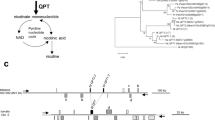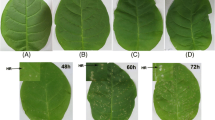Abstract
Tobacco genes that are induced in response to salicylic acid (SA) treatment with immediate-early kinetics were identified by differential mRNA display. Detailed analysis of IS10a, one cDNA clone identified by this method, revealed induction within 30 min of treatment, with a peak of expression at 3 h, that decayed rapidly thereafter. Treatment with the protein synthesis inhibitor, cycloheximide (CHX), also caused induction of IS10a mRNA to comparable levels, but the IS10a mRNA continued to accumulate after 3 h of induction. In combination, CHX and SA led to a superinduction of IS10a mRNA levels that was also sustained. Half-maximal induction was evident at ca. 100–150 μM SA. In addition to SA, induction of IS10a occurred to varying degrees upon treatment with acetylsalicylic acid, benzoic acid, 2,4-dichlorophenoxyacetic acid, methyl jasmonate, and hydrogen peroxide, whereas treatment with other compounds had no effect. The proteins encoded by IS10a and a second highly homologous cDNA show sequence similarity to UDP-glucose: flavonoid glucosyltransferases.
Similar content being viewed by others
Abbreviations
- 2,4-D:
-
2,4-dichlorophenoxyacetic acid
- 4HBA:
-
4-hydroxybenzoic acid
- aa:
-
amino acid
- bp:
-
base pair
- nt:
-
nucleotide
- ASA:
-
acetyl salicylic acid
- BA:
-
benzoic acid
- CHX:
-
Cycloheximide
- MJ:
-
methyl jasmonate
- PCR:
-
polymerase chain reaction
- SA:
-
salicylic acid
- TMV:
-
tobacco mosaic virus
References
Altschul SF, Gish W, Miller W, Myers EW, Lipman DJ: Basic alignment search tool. J Mol Biol 215: 403–410 (1990).
An G, Costa MA, Ha S-B: Nopaline synthase promoter is wound inducible and auxin inducible. Plant Cell 2: 225–233 (1990).
Asselin A, Grenier J, Cote F: Light- accumulation of b (pathogenis-related) proteins inNicotiana green tissue induced by various chemicals or prolonged floating on water Can J Bot 63: 1276–1282 (1985).
Bi Y-M, Kenton P, Mur L, Darby R, Draper J: Hydrogen peroxide does not function downstream of salicylic acid in the induction of PR protein expression. Plant J 8: 235–245 (1995).
Boot KJM, van der Zaal BJ, Velterop J, Quint A, Mennes AM, Hooykaas PJJ, Libbenga KR: Further characterization of expression of auxin-induced genes in tobacco (Nicotiana tabacum) cell-suspension cultures. Plant Physiol 102: 513–520 (1993).
Boutry M, Chua N-H: A nuclear gene encoding the beta subunit of the mitochondrial ATP synthase inNicotiana plumbaginifolia. EMBO J 4: 2159–2165 (1985).
Chen Z, Ricigliano JW, Klessig DF: Purification and characterization of a soluble salicylic acid-binding protein from tobacco. Proc Natl Acad Sci USA 90: 9533–9537 (1993).
Chen Z, Silva H, Klessig DF: Active oxygen species in the induction of plant systemic acquired resistance by salicylc acid. Science 262: 1883–1886 (1993).
Cleland CF, Ajami A: Identification of the flower-inducing factor isolated from aphid honeydew as salicylic acid. Plant Physiol 54: 904–906 (1974).
Dai Z, An G: Induction of nopaline synthase promoter activity by H2O2 has no direct correlation with salicylic acid. Plant Physiol 109: 1191–1197 (1995).
Dietrich A, Mayer JE, Hahlbrock K: Fungal elicitor triggers rapid, transient, and specific protein phosphorylation in parsley cell suspension cultures. J Biol Chem 265: 6360–6368 (1990).
Droog FNJ, Hooykaas PJJ, Libbenga KR, van der Zaal EJ: Proteins encoded by an auxin-regulated gene family of tobacco share limited but significant homology with glutathioneS-transferases and one member indeed showsin vitro GST activity. Plant Mol Biol 21: 965–972 (1993).
Enyedi AJ, Yalpani N, Silverman P, Raskin I: Localization, conjugation, and function of salicylic acid in tobacco during the hypersensitive reaction to tobacco mosaic virus. Proc Natl Acad Sci USA 89: 2480–2484 (1992).
Felix G, Grosskopf DG, Regenass M, Boller T: Rapid changes of protein phosphorylation are involved in transduction of the elicitor signal in plant cells. Proc Natl Acad Sci USA 88: 8831–8834 (1991).
Felix G, Meins FJr: Developmental and hormonal regulation of β-1,3-glucanase in tobacco. Planta 167: 206–211 (1986).
Fritzemeier K-H, Cretin C, Kombrink E, Rohwer F, Taylor J, Sheel D, Hahlbrock K: Transient induction of phenylalanine ammonia-lyase and 4-coumarate: CoA ligase mRNAs in potato leaves infected with virulent or avirulent races ofPhytophthora infestans. Plant Physiol 85: 34–41 (1987).
Green PJ: Control of mRNA stability in higher plants. Plant Physiol 102: 1065–1070 (1993).
Hennig J, Malamy J, Grynkiewicz G, Indulski J, Klessig DF: Interconversion of the salicylic acid signal and its glucoside in tobacco. Plant J 4: 593–600 (1993).
Herschman HR: Primary response genes induced by growth factors and tumor promoters. Annu Rev Biochem 60: 281–319 (1991).
Jepson I, Lay VJ, Holt DC, Bright SWJ, Greenland AJ: Cloning and characterization of maize herbicide safenerinduced cDNAs encoding subunits of glutathioneS-transferase isoforms I, II and IV. Plant Mol Biol 26: 1855–1866 (1994).
Jung J-L, Maurel S, Fritig B, Hahne G: Different pathogenesis-related-proteins are expressed in sunflower (Helianthus annuus L.) in response to physical, chemical and stress factors. J Plant Physiol 145: 153–160 (1995).
Kapulnik Y, Yalpani N, Raskin I: Salicylic acid induces cyanide-resistant respiration in tobacco cell cultures. Plant Physiol 100: 1921–1926 (1992).
Kato K, Matsumoto T, Koiwai A, Mizusaki S, Nishida K, Noguchi M, Tamaki E: Liquid suspension culture of tobacco cells. In: Terui G (eds) Fermentation Technology Today, pp. 689–695. Society for Fermentation Technology, Osaka (1972).
Kim S-R, Kim Y, An G: Identification of methyl jasmonate and salicylic acid response elements from the nopaline synthase (nos) promoter. Plant Physiol 103: 97–103 (1993).
Koes RE, Quattrocchio F, Mol JNM: The flavonoid biosynthetic pathway in plants: function and evolution. BioEssays 16: 123–132 (1994).
Kroon J, Souer E, de Graaff A, Xue Y, Mol J, Koes R: Cloning and structural analysis of the anthocyanin pigmentation locusRt ofPetunia hybrida: characterization of insertion sequences in two mutant alleles. Plant J 5: 69–80 (1994).
Lam E, Benedyk M, Chua N-H: Characterization of phytochrome-regulated gene expression in a photoautotrophic cell suspension: possible role for calmodulin. Mol Cell Biol 9: 4819–4823 (1989).
Lawton MA, Lamb CJ: Transcriptional activation of plant defense genes by fungal elicitor, wounding, and infection. Mol Cell Biol 7: 335–341 (1987).
Levine A, Tenhaken R, Dixon R, Lamb C: H2O2 from the oxidative burst orchestrates the plant hypersensitive disease resistance response. Cell 79: 583–593 (1994).
Lewis EJ, Harrington CA, Chikaraishi DM: Transcriptional regulation of the tyrosine hydroxylase gene by glucocorticoid and cyclic AMP. Proc Natl Acad Sci USA 84: 3550–3554 (1987).
Liang P, Pardee AB: Differential display of eukaryotic messenger RNA by means of the polymerase chain reaction. Science 257: 967–971 (1992).
Liu X, Lam E: Two binding sites for the plant transcription factor ASF-1 can respond to auxin treatments in transgenic tobacco. J Biol Chem 269: 668–675 (1994).
Logemann J, Schell J, Willmitzer L: Improved method for the isolation of RNA from plant tissues. Anal Biochem 163: 16–20 (1987).
Malamy J, Carr JP, Klessig DF, Raskin I: Salicylic acid: a likely endogenous signal in the resistance response of tobacco to viral infection. Science 250: 1002–1004 (1990).
Mehdy M: Active oxygen species in plant defense against pathogens. Plant Physiol 105: 467–472 (1994).
Mo Y, Nagel C, Taylor LP: Biochemical complementation of chalcone synthase mutants defines a role for flavonols in functional pollen. Proc Natl Acad Sci USA 89: 7213–7217 (1992).
Morgan JI, Curran T: Stimulus-transcription coupling in neurons: role of cellular immediate-carly genes. Trends Neurosci 12: 459–462 (1989).
Murashige T, Skoog F: A revised medium for rapid growth and bioassays with tobacco tissue culture. Physiol Plant 15: 493–497 (1962).
Neuenschwander U, Vernooij B, Friedrich L, Uknes S, Kessman H, Ryals J: Is hydrogen peroxide a second messenger of salicylic acid in systemic acquired resistance? Plant J 8: 227–233 (1995).
Ohme-Takagi M, Taylor CB, Newman TC, Green PJ: The effect of sequences with high AU content on mRNA stability in tobacco. Proc Natl Acad Sci USA 90: 11811–11815 (1993).
Pfitzner UM, Pfitzner AJ, Goodman HM: DNA sequence analysis of a PR1a gene from tobacco: molecular relationship of heat shock and pathogen responses in plants. Mol Gen Genet 211: 290–295 (1988).
Picton S, Gray J, Barton S, AbuBakar U, Lowe A, Grierson D: cDNA cloning and characterisation of novel ripening-related mRNAs with altered patterns of accumulation in theripening inhibitor (rin) tomato ripening mutant. Plant Mol Biol 23: 193–207 (1993).
Qin X, Holuigue L, Horvath DM, Chua N-H: Immediate-early induction of transcription by salicylic acid viaas-1. Plant Cell 6: 863–874 (1994).
Ralston EJ, English JJ, Dooner HK: Sequence of threebronze alleles of maize and correlation with the geneic fine structure. Genetics 119: 185–197 (1988).
Raskin I, Turner IM, Melander WR: Regulation of heat production in the influorescences of anArum lily by endogenous salicylic acid. Proc Natl Acad Sci USA 86: 2214–2218 (1989).
Rasmussen JB, Hammerschmidt R, Zook MN: Systemic induction of salicylic acid accumulation in cucumber after inoculation withPseudomonas syringeae pv.syringeae. Plant Physiol 97: 1342–1347 (1991).
Rhoads DM, McIntosh L: Salicylic acid regulation of respiration in higher plants: alternative oxidase expression. Plant Cell 4: 1131–1139 (1993).
Sandermann HJr: Higher plant metabolism of xenobiotics: the ‘green liver’ concept. Pharmacogenetics 4: 225–241 (1994).
Sembdner G, Atzorn R, Schneider G: Plant hormone conjugation. Plant Mol Biol 26: 1459–1481 (1994).
Shirzadegan M, Christie P, Seeman JR: An efficient method for the isolation of RNA from tissue cultured plant cells. Nucl Acid Res 19: 6055 (1991).
Shyu A-B, Greenberg ME, Belasco JG: Thec-fos transcript is targeted for rapid decay by two distinct mRNA degradation pathways. Genes Devel 3: 60–72 (1989).
Sparvoli F, Martin C, Scienza A, Gavazzi G, Tonelli G, Cloning and molecular analysis of structural genes involved in flavonoid and stilbene biosynthesis in grape (Vitis vinifera L.) Plant Mol Biol 24: 743–755 (1994).
Staskawicz BJ, Ausubel FM, Baker BJ, Ellis JG, Jones JDG: Molecular genetics of plant disease resistance. Science 268: 661–667 (1995).
Szerszen JB, Szczyglowski K, Bandurski RS:iaglu, a gene fromZea Mays involved in conjugation of growth hormone indole-3-acetic acid. Science 265: 1699–1701 (1994).
Takahashi Y, Nagata T:parB: an auxin-regulated gene encoding glutathioneS-transferase. Proc Natl. Acad Sci USA 89: 56–59 (1992).
Theologis A, Huynh TV, Davis RW: Rapid induction of specific mRNAs by auxin in pea epicotyl tissue. J Mol Biol 183: 53–68 (1985).
Uknes S, Dincher S, Friedrich L, Negrotto D, Williams S, Thompson-Taylor H, Potter S, Ward E, Ryals J: Regulation of pathogenesis-related protein-la gene expression in tobacco. Plant Cell 5: 159–169 (1993).
van Loon LC: The induction of pathogenesis-related proteins by pathogens and specific chemicals. Neth J Plant Pathol 89: 265–273 (1983).
Vera-Estrella R, Barkla BJ, Higging VJ, Blumwauld E: Plant defense response to fungal pathogens. Plant Physiol 104: 209–215 (1994).
Ward ER, Uknes SJ, Williams SC, Dincher SS, Wiederhold DL, Alexander DC, Ahl-Goy P, Métraux J-P, Ryals JA: Coordinate gene activity in response to agents that induce systemic acquired resistance. Plant Cell 3: 1085–1094 (1991).
Wise RP, Rohde W, Salamini F: Nucleotide sequence of theBronze-1 homologous gene fromHordeum vulgare. Plant Mol Biol 14: 277–279 (1990).
Yalpani N, Balke NE, Schulz M: Induction of UDP-glucose:salicylic acid glucosyltransferase in oat roots. Plant Physiol 100: 1114–1119 (1992).
Yalpani N, Schultz M, Davis MP, Baker NE: Partial purification and properties of an inducible uridine 5′-diphosphate-glucose:salicylic acid glucosyltransferase from oat roots. Plant Physiol 100: 457–463 (1992).
Yalpani N, Silverman P, Wilson TMA, Kleier DA, Raskin I: Salicylic acid is a systemic signal and an inducer of pathogenesis-related proteins in virus-infected tobacco. Plant Cell 3: 809–818 (1991).
Author information
Authors and Affiliations
Rights and permissions
About this article
Cite this article
Horvath, D.M., Chua, NH. Identification of an immediate-early salicylic acid-inducible tobacco gene and characterization of induction by other compounds. Plant Mol Biol 31, 1061–1072 (1996). https://doi.org/10.1007/BF00040724
Received:
Accepted:
Issue Date:
DOI: https://doi.org/10.1007/BF00040724




